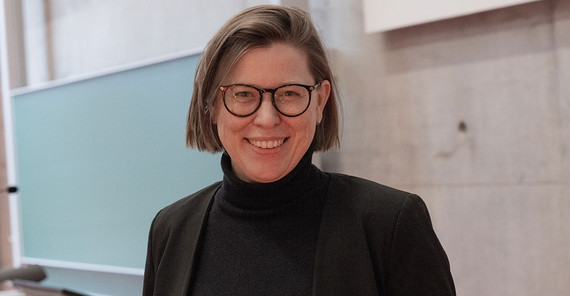You conducted a study together with Nadine Ketel from Vrije Universiteit Amsterdam on the economic implications of crime that received a lot of attention. What makes this study special?
We had observed that research primarily concentrated on the question of how to effectively curb crime. To answer this question, we should know what social and security policy measures against crime cost us and whether they actually help. It is relatively easy to calculate the expenditures for such measures. We know how much money we have to spend, for example, on video surveillance or a police operation. Their benefits, on the other hand, are much more difficult to define. And this is somehow squaring the circle, so to speak: we want to find out what crime costs us that never took place – because we prevented it. This means that we are faced with two challenges. First, how do you measure prevented crime? And secondly, how do you measure expenditure on prevented crime? This is where we started to identify what crime costs from an economic, social, and individual point of view. For the study, we connected data from the Dutch police from the 2000s with labor market data. In this way, we were able to understand how the careers of people who were victims of crime continued within the first years after the crime – or perhaps not. What happened to their incomes? Did they need social benefits? How high were the expenses for medical treatment that became necessary after the crime?
What did you find out?
The income of victims decreased, and they were more likely to rely on social benefits and had higher medical treatment costs than before the crime. By the way, people who were already precariously employed are particularly affected. The consequences of the crime also depend on its form. We examined four categories: assault, threats of violence – which also includes stalking – robberies, and burglaries with and without violence. The study shows that the financial consequences of violent crimes are more severe. In addition, the effects are somewhat more pronounced in female than in male victims. Women earn up to 12.9 % less per month, compared to 8.4 % less for men. Female victims receive an average of 6% more social benefits than before the crime, male victims up to 5%. If we include domestic violence, the losses suffered by women are even more serious.
How do you explain these differences?
That’s the big question! It is possible that this inequality can be explained through the different labor market behavior of women and men: their careers are different, women have lower earnings on average. However, the cause could also lie in the data itself because it only covers cases in which those affected have gone to the police – and the willingness to report an incident may differ between women and men.
You have also investigated whether men and women are treated equally by the judicial system.
In a study with historical data, we examined cases in a London court from the 18th to the end of the 19th century and found out how conviction rates for men and women developed. Over the entire period, women were convicted less often than men who were on trial for the same crime. We are talking about positive discrimination here. There seems to be a paternalistic mechanism behind this – a social doubt as to whether women are capable of committing a crime at all.
We have already mentioned the financial consequences for victims of crime. However, the costs for police, court, and detention have to be borne by all. What are the costs of crime for the economy of a country?
Previous estimates have mainly referred to direct costs, e.g., for criminal proceedings, police operations, or material damage. However, if indirect costs such as losses on the labor market are included, these estimates are 10% too low. The loss of income in the Netherlands in the first year after victimization amounts to about 72 million euros. This is more than double of what was paid at that time for compensation payments from perpetrators to victims. Our data also shows that even four years later, the victims have not yet achieved their original income.
What consequences should political stakeholders draw from these findings? Do you consider it reasonable to increase the penalties to deter potential perpetrators?
From my point of view, it is important to consider three aspects. Firstly, prevention, which is about preventing people from becoming criminals. Education is one of the best measures here. Secondly, repression: how can the police and judiciary better investigate crimes? Thirdly, we need effective victim assistance that provides better support to those affected, for example with the help of protection against violence laws.
I think that we have a reasonable penal law, but this can only be exhausted if perpetrators are taken to court. In my view, it is therefore more important and effective to focus on their implementation rather than increasing penalties, i.e., increasing the crime-solved record and punishing perpetrators in accordance with the existing penal law.
Who actually are the victims of crime? Is there a statistical answer to this?
Yes and no. We looked at the average income in Dutch police reports and compared them to a random sample of the population. Statistically, people who are victims of violence tend to belong to disadvantaged population groups: they have a lower income on average, are more often unemployed, and receive social benefits. They are more likely to work in precarious employment, i.e., with fixed-term contracts or with temporary employment agencies. This means that they are less protected under labor law.
In another study, we looked at the age distribution, also in the Netherlands: young people have a higher risk of becoming victims than older people.
What might be the reasons?
As far as victims’ prospects are concerned, sociological theories say that crime takes place when there is an opportunity for it, i.e., when potential victims and potential perpetrators meet. If they do not meet, it does not take place. We are interested in which factors increase the probability that a crime will occur. To do this, we have to look at what is happening in people’s homes, at work, and in their free time. On average, 18-20-year-old people go out more often, visit clubs, and drink alcohol. They therefore encounter potential risks more often than people in their mid-30s or 40s, who may spend the weekend at home or with their children. When young people get basic rights when they attain majority age, their habits change. The risk of becoming a victim of a crime then increases sharply. In the Netherlands, the minimum age for drinking alcohol and visiting clubs and bars was raised from 16 to 18 years a few years ago. This reduced the likelihood of becoming a victim of crime among young people. But that does not mean that going out should be banned – after all, going out is a nice thing. But one should think about how crimes could be curbed here, for example through information on alcohol consumption or even through personal precautions.
The risk of turning to crime is also highest at a young age, in many countries in the early 20s. This was already the case in the 19th century, as historical court data show. From a psychological, sociological, and economic point of view, this is a time in life when many things are decided: school time comes to an end and professional life begins.
What would we need to protect young people from a criminal path?
There is a connection between unemployment among young people and crime. That’s why it is important to provide good career opportunities. We investigated this in a study. In simple terms, we compared the life trajectories of two people: one of them encounters a good job market after school and soon finds a job. The other graduates at an inopportune time and remains unemployed. The probability that the latter will become criminal is higher than with the first person. However, this does not mean that every person who experiences unemployment becomes criminal.
Your research perspective is considered unique in Germany. How did you get here?
This field of research is strongly growing internationally, but in Germany it is actually still quite small. I came across it at University College in London, where I attended courses as part of my structured doctoral program. My later doctoral supervisor gave a lecture on “Economics of Crime”. I found that extremely interesting and developed ideas for my dissertation. It is important to me to combine scientific work with social values.
This connection is also reflected in the fact that you were awarded the “Wissenschaftspreis Opferschutz” by the victim protection organization WEISSER RING and the German Federal Office of Criminal Investigation (BKA) in 2023.
I was very happy about that. It is a great honor to be able to work beyond the narrow circle of academia. I am pleased that the results not only contribute to the scientific discourse but also have the added value in practice that we hope for.
Anna Bindler has been a jointly appointed Professor of Applied Microeconomics at the German Institute for Economic Research (DIW) and the University of Potsdam since 2024.
This text was published in the university magazine Portal – One 2025 “Children” (PDF).


